Friday, 6 May 2011
Thursday, 14 April 2011
How did you attract/address the audience?
We used a number of techniques to attract our audience, including defining the drama which immediately grabbed the audience's attention. Firstly our main character is a young, male in his late teens to early adulthood. We chose him to be the lead as because he is a similar age to our target audience (12-30) they can relate to him a lot more and also shows how many audience members would act if they were in a similar situation. There is a large age range however the camera work, catchy plot line and the fact this is a drama keeps everyone intrigued and wanting to watch more. We decided upon the title of ‘Lily’ because it has a variety of connotations branching from it. A lily makes us think of a beautiful untouched white flower, however it could also be the name of a person so this makes the audience want to find out more. I think a one-word name is also effective, as it doesn’t give much insight into the film so this also attracts the attention of the audience. I think the flashbacks in our opening sequence make it a lot more personal and as it is from Matt’s perspective it is a lot more personal and distinctive and the audience can relate in some ways as to how he is feeling. The opening of the film is an establishing shot showing Matt in a graveyard walking with flowers in his hand this sets the mood straight away and shows the audience exactly what to expect in the film
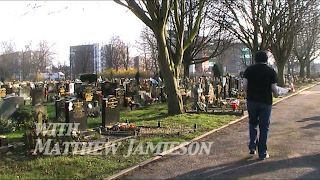
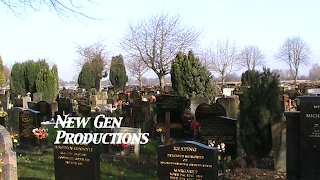
We have also used sound to grab the audience’s attention, e.g. the music, voiceover and sound effects. These are used to create a tense atmosphere, for example when Matt is having a flashback, the music suddenly changes from the sad tone to a happier tone, this will hopefully draw the audience in as they will want to find out what happens next. Our editing has helped to attract audience to as during it we included some shots of the girl across the road and then a car passes and she is gone, this creates a sense of mystery and will hopefully get the audience questioning thus making them watch more of the film to get those questions answered. The final technique used was the mise on scene; in terms of the costumes for both characters we used ordinary clothes for the age group so the audience are able to relate to and darker ones when he was upset. In terms of the location we chose a graveyard, this is not a usual setting for a drama and will be something the audience are not expecting.
What kind of media institution would distribute your media product and why?
The type of media institution that would distribute our product would more than like be British production companies, this is because it is based in Britain and the locations it has been filmed in you can associate with Britain e.g. a local park. Also our budget is very low, we only spent money on key props e.g. the lily etc. The timing for our film was obviously very compact and nothing in terms of timing for a Hollywood blockbuster and our special effects are minimal unlike Hollywood where they have the money to have top of the range equipment and technology, whereas we have basic editing tools and we are not professionals so our skills are basic, unlike Hollywood’s where they have the money to hire trained professionals.
Remember me and Ps. I Love You are films in which, to a certain extent are similar to ours. Remember me’s main production company and distributor is Summit Entertainment. Ps I love you is produced and distributed by Warner Bros. Pictures.
These distributors and production companies are very big and well know and if we’re realistic we know they wouldn’t distribute our media product. We did some extensive research into what kind of low budget independent British film companies would produce or distribute our products. An option we could consider is Film4 Productions, who are owned by channel 4. They produced a lot of films made in the UK and most of them being low budget, e.g. Trainspotting.
Working Title 2 is another low budget film company who produced films such as Billy Elliott and Shaun of the dead; these might also be interested in our media product. Our film could be marketed in magazines that women read, advertisements on the interment and trailers.
Places we could market such a film such as ours are places such as New Market Films. Its could be hard to raise awareness for our film with no existing popularity, so social networking sites such as Facebook and Myspace could be used to gain popularity and post trailers and posters, this would help us to post links to sites where our film can be streamed for fee’s and memberships etc. It would be best to market our film on the European film market because going worldwide would be very difficult at such an early stage. Also a good place to advertise would be adverts in womans magazines, although this could prove to be pricey and as we don’t have high funding this may not be possible.

Who would be the audience for your media product?
When planning our product we decided to aim for a teenage audience of ages between 13-19. This is because it is teenagers that are the mainstream audience as it seem to be customers within this age range who visit the cinemas the most.
It is possible that even younger audiences could watch this film, but because of its social complexity and emotion; the audience may prove the product to be unsuitable and find it boring or too confusing to understand.
A way that we have achieved our target audience is by involving characters in the age range in the product e.g. the main character is a teenager himself. If the audience sees someone that can relate to them like their age range, they can put themselves in the shoes of the characters and enjoy the film a lot more.
Looking deeper into what gender the audience will be seems to be targeted as female. This is due to the genre of the film. Dramas are known for their social complexity and emotion filled scenes. This is what attracts the female audience to this genre.
Because of the social complexity and emotion in the film, this will give the product more of a niche audience of older, more sophisticated audience. An audience of this seems to be a lot older than our targeted audience and will expand more to the older audience between ages of 20-40.
The male audiences stereotypically are more lenient towards action films with exciting plots. However, the male audience could be part of the target audience for this product as it has a leading male part. Seeing this male lead role may attract the male audience to watch this film.
But of course, more educated male audience could be attracted to this the same way female audiences are with the complexity and emotion. An audience like this would be students in collage or university, but also expanding to even older ages of men e.g. men who like to read or intelligent males.
Other members of different audiences could be attracted to this because of the plot of the story. The plot in our production involves the loss of a loved one. Of course this may be a reality for some people, this could attract them to the product and will make them want to watch it.
Films like “P.S. I Love You” is very similar to my product. This is because of the shared genre and plot. A film like “P.S. I Love You” shares the target audience that our product has, and like I have established, the audience seems to be the female audience with ages between 16- 30. However, “P.S. I Love You” is also a romance and a romance is a genre that highly targets the female audience whereas we are also trying to reach out to the male audience.
How does your media product represent particular social groups?
The opening of our film shows a young adult male, who is the main protagonist in our film, grieving for his partner who has died. The whole film opening follows him and his remorse however flashbacks show the girl who has died, the audience are unaware that this is the case though at this time. We decided to use the female character in her late teens as the one who has died and a male character in his late teens as the main protagonist. We decided to use this age of the characters as normally at that age they should be out socializing and having fun whereas the male character looks as though his life is more or less over because of this, this would have a greater effect on the audience as they are around that age so it is easier to relate to. In films such as ‘Ps I Love You’ the main protagonist in this film is a female, and this usually is the case in most dramas similar to ours, this is because it is normally easier to show a females emotions as men stereotypically don’t outwardly show theirs. However in our film it is the female who has died and we are following the emotions of the male, this breaks stereotypes of men being strong and not showing their emotion,
Bringing a twist to our film and making it seem more interesting and appealing to audiences. The breaking of stereotype could bring interest from the teenage male audience, however it is aimed mainly at females as they are more into psychological and emotional films. Our film doesn’t exactly portray a particular group of people, it just looks at a death and how it can effect the life of a certain person, it shows a negative representation on young love and how it can ruin someone s life if things go wrong which in this case they obviously have.

Ethnic stereotypes could be pointed at in this film as it is focuses on a white couple, if one of the partners were of another ethnicity it would break typical stereotypes, however this isn’t the case in our film.
People usually relate graveyards with elderly people however in our film the dead person is a teenage girl, thus making everything seem more upsetting because she has obviously died very young. This is where the connection with the teenage audience comes into place as the focus is around a girl a similar age to themselves. As there is a young blonde female as the leading role this can also bring lots of attention to this film, as say if it were advertised for example, audiences may come just to see her in the film.
In what way does your media product use, develop or challenge forms and conversations of real media products?
The genre of film we have made is a drama. Our opening sequence of the film and how this may lead on is similar to films like “P.S. I Love You” and “Remember Me”. This is mainly due to the plot but also because of how they show emotion in the films.
“P.S I love You” is a good example of this, in our opening sequence we show memories of how Lily and the main character were very happy together, “P.S. I Love You” is similar by showing the moment the couple meets. It shows a contrast between emotion of happiness and remorse.
The non-diagetic sound (in this case, the music) matches the mood of the film. This again can be shown by “P.S. I Love You” as music is used at the start of the film that links in with the film, “P.S. I Love You” has Irish Folk songs at the start; this link in the film as it announces location and also link with a character as he himself is Irish.
Our opening music has the voiceover of the main character reading a voiceover narration (which is also non-diagetic) that relates to his story of losing his partner.
How we written the music and lyrics with is breaks conventions of drama films like this as like in “P.S. I Love You” they use a pre-recorded Irish Folk song. We had to write and record our sound ourselves and add it to the film.
Camera work for our product was very basic and nothing specific was used, however we deliberately use a lot of close up, this opening scene is all about the emotions the main character is feeling and the close ups will show them to the audience. We kept to the 180 degree rule, we used establishing shots to show the audience the location and also tracking shots of the main character.
Our editing of the opening scene is good. There is two points in the film where accuracy was key, the scene on the swings and when the main character sees Lily across the road. At both point we had to shoot two scenes and edit them in such a way that they molded together seamlessly. The use of elliptical editing and match cuts in the film to help the audience follow the film much easier.
What is original about our production would be the sound; this is because we created the music ourselves. We created the music on Sibelius 6. It was created in a manner that matches the mood of the film and followed the mood till the end of the opening sequence.

Looking back at the preliminary task, what do you think you have learnt from the progression from it to the full task?
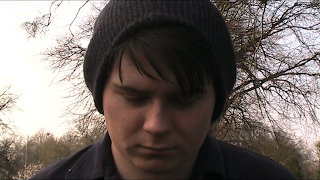 along with a few more different shots like long shots and two shots later on in the sequence. The skills we learnt in the preliminary were mainly skills in filming, such as learning about the rule of thirds and the 180 degree rule, which we made sure we used throughout our film. We learnt a lot more however, this was mainly in the editing aspect, where we learnt about the different effects we can put for the filters of the frames along with the different effects we could use in the transitions between shots. This was to create a better feel in the film, and add to the emotion of it. We needed a lot
along with a few more different shots like long shots and two shots later on in the sequence. The skills we learnt in the preliminary were mainly skills in filming, such as learning about the rule of thirds and the 180 degree rule, which we made sure we used throughout our film. We learnt a lot more however, this was mainly in the editing aspect, where we learnt about the different effects we can put for the filters of the frames along with the different effects we could use in the transitions between shots. This was to create a better feel in the film, and add to the emotion of it. We needed a lot 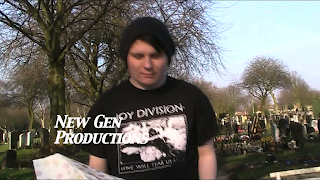 more skills in editing for our main task than in our preliminary as there was a lot more to it, for example we had a voiceover to fit over the film, along with music. There were also a lot more shots to deal with, and we had to make our main task look a lot more professional than the preliminary because that time it wasn't just practice.
more skills in editing for our main task than in our preliminary as there was a lot more to it, for example we had a voiceover to fit over the film, along with music. There were also a lot more shots to deal with, and we had to make our main task look a lot more professional than the preliminary because that time it wasn't just practice. 
Tuesday, 12 April 2011
What have you learnt about technologies from the process of constructing this product?
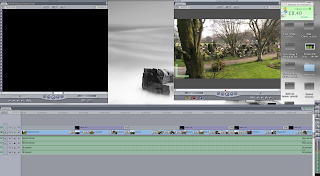 We used a cross-fade between every shot in our footage to give more of a nostalgic, dreamy effect. This is because the main character is feeling nostalgic feelings about his dead lover and he is dreaming and reminiscing about the older, happier times with her. We also used a black-and-white filter for the memories he had to determine the difference between past and present, helping it to be slightly easier for the audience to understand. We played with a few other effects in the filters too which gave some effects that seemed very good to use in the memories. For example there was a glow effect, along with a desaturate effect.
We used a cross-fade between every shot in our footage to give more of a nostalgic, dreamy effect. This is because the main character is feeling nostalgic feelings about his dead lover and he is dreaming and reminiscing about the older, happier times with her. We also used a black-and-white filter for the memories he had to determine the difference between past and present, helping it to be slightly easier for the audience to understand. We played with a few other effects in the filters too which gave some effects that seemed very good to use in the memories. For example there was a glow effect, along with a desaturate effect.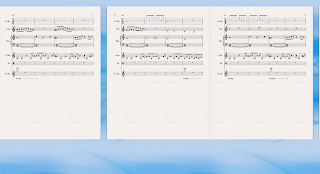 We used this to input the notes needed for the music, we then learnt how to transfer this file to a file suitable for use on Final Cut Pro. We also used logic, to both change the music and store the voiceover on, and also to change that. We had problems in the dynamics of the music so that was the problem we overcome by adjusting the volumes on logic. With the voiceover we were frequently adjusting it by spreading out the utterances to make the voiceover last longer. Also we used recording instruments to record our voiceover, such as microphones and handheld voice recorders. We learnt a lot from doing this, especially how to export the recordings into different formats for use in Final Cut Pro. Our voiceover was a problem as it was usually either too short or too long for the 2 minute sequence we had, therefore we recorded it many more times so we could perfect it.
We used this to input the notes needed for the music, we then learnt how to transfer this file to a file suitable for use on Final Cut Pro. We also used logic, to both change the music and store the voiceover on, and also to change that. We had problems in the dynamics of the music so that was the problem we overcome by adjusting the volumes on logic. With the voiceover we were frequently adjusting it by spreading out the utterances to make the voiceover last longer. Also we used recording instruments to record our voiceover, such as microphones and handheld voice recorders. We learnt a lot from doing this, especially how to export the recordings into different formats for use in Final Cut Pro. Our voiceover was a problem as it was usually either too short or too long for the 2 minute sequence we had, therefore we recorded it many more times so we could perfect it.Thursday, 31 March 2011
Initial Ideas.
When we started looking into what kind of film opening we wanted we considered a variety of options and played around with a few ideas. One initial idea was to do a musical, but when thinking and researching we realised how hard that this type of genre would be to do, for example we would have needed to find enough volunteers to take part, as musicals usually have a high number of people and also we would have required a good choreographer for it to work for us, thus ruling this idea out. Another idea we had was to do a comedy, but again we thought this wouldn't demonstrate our skills well enough so we chose not to follow up on this idea.
In the end we all agreed on the genre of drama, this is because we could show what we could do when it comes to filming and editing. You can also tell that a film is initially a drama in the opening as they don't tend to have lots of special effects and editing. Doing a drama opening isn't as hard to do compared to other genres, e.g. comedies and musicals where the openings don’t actually show their genre till quite a bit into the film. Everyone being happy we went on to plan and film our opening.
Chorlton park because it was big and there were lots of places to film the happy memories.

We decided to film our sad memories in the southern cemetery, this fit in perfectly with what we wanted to do. We also found a suitable cross where we could film the main part of our opening. The cross was perfect as it was plain and didn't have a name on it, we wanted this as it would keep the audience guessing as to what it was that had happened.




